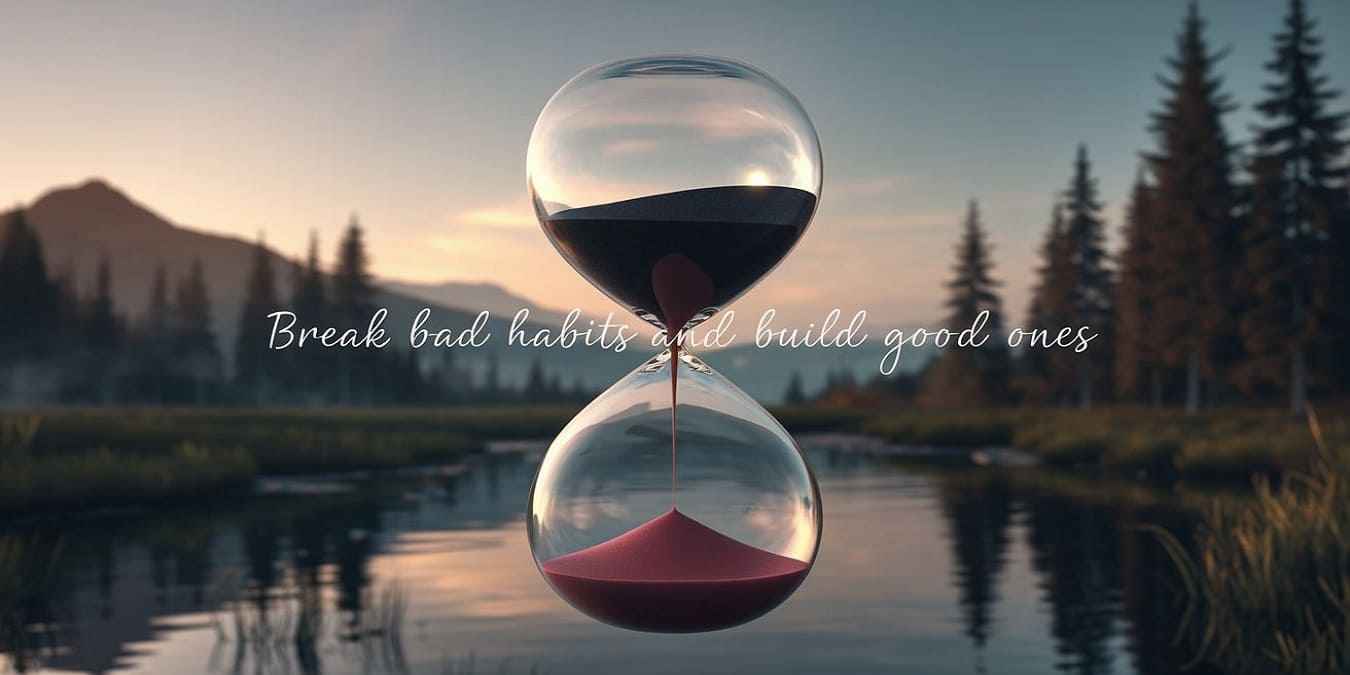
How to Break Bad Habits and Build Good Ones
Imagine this: You wake up every morning determined to make a change. Maybe it’s quitting that late-night snack habit, cutting back on screen time or finally starting that daily exercise routine you’ve been promising yourself for years.
But by the end of the day, you find yourself stuck in the same old patterns, wondering why breaking bad habits feels so impossible. If this sounds familiar, don’t worry, you’re not alone.
The truth is, bad habits are sneaky. They creep into our lives unnoticed and dig their roots deep into our routines. But here’s the good news: with the right strategies, you can break free from these patterns and replace them with good habits that truly transform your life.
As Will Durant once said, “We are what we repeatedly do. Excellence, then, is not an act but a habit.” This simple yet profound insight reminds us that the small, consistent actions we take each day shape who we become.
So, if you’re ready to take control of your habits, let’s dive into how you can break bad habits and build good ones that last.
Why Do We Form Bad Habits?
Before we talk about breaking bad habits, it’s important to understand why we form them in the first place. Habits, whether good or bad, develop because they serve a purpose. At their core, habits are shortcuts, automatic behaviors that save our brains energy.
For example, biting your nails might relieve stress temporarily or scrolling through social media could provide a quick dopamine hit. While these actions may feel harmless at first, over time, they can become deeply ingrained patterns that hold us back.
But here’s the catch: bad habits aren’t just annoying quirks, they often come at a cost. Whether it’s procrastination keeping you from reaching your goals or unhealthy eating habits affecting your well-being, the consequences of bad habits can ripple through every area of your life.
So, ask yourself: What are the costs of continuing down this path? And more importantly, are you willing to do something about it?
The Science Behind Habits: How They Work
To break bad habits, it helps to understand the science behind them. According to Charles Duhigg, author of The Power of Habit, every habit follows a simple loop: Cue, Routine, Reward . Here’s how it works.
- Cue : This is the trigger that tells your brain to go into automatic mode. It could be a feeling (like boredom), a location (your couch) or even a time of day (right after dinner).
- Routine : This is the behavior itself, the action you take in response to the cue. For instance, reaching for a cigarette when you feel stressed.
- Reward : This is the payoff that reinforces the habit. In the case of smoking, the reward might be a temporary sense of calm or distraction.
Understanding this loop is key to breaking bad habits. By identifying the cues and rewards driving your behavior, you can begin to disrupt the cycle and replace it with healthier alternatives.
Step 1: Identify Your Triggers
The first step in breaking bad habits is pinpointing what triggers them. Without awareness, it’s nearly impossible to create lasting change. Start by asking yourself:
- When does this habit usually occur? Each question should help you uncover the specific situations, emotions or environments that lead to the behavior. For example, if you tend to snack late at night, your trigger might be boredom or stress rather than hunger.
Once you’ve identified your triggers, write them down. Seeing them on paper makes them easier to address and gives you clarity on where to focus your efforts.
Step 2: Replace, Don’t Just Remove, Replace
One of the biggest mistakes people make when trying to break bad habits is focusing solely on stopping the behavior. However, simply removing a habit without replacing it leaves a void and nature hates a vacuum. Instead, aim to replace the bad habit with a positive one that fulfills the same need.
For instance, if you’re trying to quit mindlessly scrolling through your phone before bed, consider swapping it with a calming bedtime ritual like reading or journaling. Both activities provide relaxation and mental stimulation, but one supports your long-term goals while the other doesn’t.
Remember, the goal isn’t perfection, it’s progress. Even small substitutions can make a big difference over time.
Step 3: Start Small and Build Momentum
When building good habits, it’s tempting to aim for sweeping changes overnight. But research shows that sustainable change happens gradually. James Clear, author of Atomic Habits, emphasizes the importance of starting small. He suggests using the “1% Rule”: Improving by just 1% each day compounds into massive results over time.
Instead of committing to an hour-long workout every morning, start with five minutes of stretching. Want to read more? Begin with one page per day. These tiny actions may seem insignificant at first, but they lay the foundation for bigger achievements. Over time, consistency builds momentum, making it easier to stick with your new habits.
Step 4: Create an Environment That Supports Change
Your environment plays a crucial role in shaping your habits. Think about it: if junk food is within arm’s reach, resisting cravings becomes much harder. On the flip side, surrounding yourself with cues that promote good habits can make all the difference.
Here are some practical ways to design your environment for success:
- Keep healthy snacks visible and easily accessible.
- Place books or journals near your favorite chair to encourage reading.
- Use apps or tools that limit distractions, such as website blockers or timers.
By controlling your surroundings, you reduce the friction required to adopt good habits and increase the effort needed to fall back into bad ones.
Step 5: Leverage Accountability and Support
Breaking bad habits and building good ones is rarely a solo journey. Having accountability can significantly boost your chances of success. Share your goals with a trusted friend, family member or mentor who can check in on your progress.
Better yet, team up with someone working toward similar objectives. Studies show that people who partner with others are far more likely to achieve their goals than those who go it alone.
You can also join online communities or forums dedicated to habit formation. Platforms like Reddit or Facebook groups offer spaces where individuals share tips, celebrate wins and support each other during setbacks.
Step 6: Celebrate Wins and Learn from Setbacks
Let’s face it: change isn’t linear. There will be days when you slip up and revert to old patterns. And that’s okay! What matters most is how you respond to those moments. Instead of beating yourself up, treat setbacks as learning opportunities. Ask yourself:
- What triggered the relapse?
- How can I prevent it next time?
At the same time, don’t forget to celebrate your victories, no matter how small. Positive reinforcement strengthens neural pathways associated with good habits, making them more likely to stick.
Reward yourself with something meaningful, whether it’s a relaxing bath, a movie night or simply acknowledging your progress out loud.
The Role of Mindset in Habit Formation
Mindset is everything when it comes to breaking bad habits and building good ones. Carol Dweck, a psychologist known for her work on growth mindset, explains that believing in your ability to change is half the battle.
If you view challenges as opportunities to grow rather than insurmountable obstacles, you’ll approach habit formation with resilience and optimism.
Adopting a growth mindset also means embracing imperfection. No one gets it right 100% of the time and that’s perfectly normal. As Vince Lombardi famously said, “Perfection is not attainable, but if we chase perfection, we can catch excellence.”
Common Pitfalls to Avoid
Even with the best intentions, there are pitfalls that can derail your efforts. Watch out for these common mistakes:
- Overcommitting : Trying to overhaul too many habits at once leads to overwhelm. Focus on one or two changes at a time.
- Neglecting self-care : Sleep deprivation, poor nutrition and high stress levels sabotage willpower. Prioritize your physical and mental health.
- Expecting instant results : Real change takes time. Be patient and trust the process.
By staying mindful of these traps, you’ll set yourself up for greater success.
Inspiring Quotes to Keep You Motivated
Here are a few timeless quotes to inspire you along your journey:
- “Your net worth to the world is usually determined by what remains after your bad habits are subtracted from your good ones.” – Benjamin Franklin
- “We first make our habits and then our habits make us.” – John Dryden
- “You don’t have to be great to start, but you have to start to be great.” – Zig Ziglar
These reminders underscore the transformative power of habits and the importance of taking action today.
Final Thoughts: Breaking Bad Habits for Good Ones
Breaking bad habits and building good ones isn’t easy, but it’s one of the most rewarding things you can do for yourself. By understanding the science behind habits, identifying your triggers and creating systems that support positive change, you can rewrite the script of your daily life.
Remember, the journey won’t always be smooth, but every step forward brings you closer to becoming the person you want to be.
So, ask yourself: What’s one bad habit you’re ready to let go of today? And what good habit will you embrace instead? With determination, patience and the right strategies, you have the power to transform your life, one habit at a time.
After all, breaking bad habits isn’t just about leaving something behind; it’s about stepping boldly into the future you deserve.
Your habits don’t define you, your actions do. Take control today: Choose one habit to break and one to build. Drop your plan in the comments and let’s create a ripple effect of positive change!”
FAQs: How to Break Bad Habits and Build Good Ones
Some frequently asked questions to help clarify common concerns and provide additional insights into breaking bad habits and building good ones.
- What exactly are bad habits and why are they so hard to break?
Bad habits are repetitive behaviors that provide short-term satisfaction but often lead to negative long-term consequences. They’re hard to break because they’re deeply ingrained in our routines and brain pathways. Over time, these habits become automatic, making them feel effortless to continue.
- Can I really break a bad habit permanently?
Yes, you can! While it takes effort and consistency, breaking a bad habit is entirely possible. The key is understanding the triggers behind the habit, replacing it with a healthier alternative and staying patient during the process. Research shows it takes an average of 21 to 66 days to form a new habit.
- How do I identify my bad habits?
Start by reflecting on your daily routines and asking yourself:
- Which behaviors make me feel guilty or unproductive?
- What activities do I turn to when I’m stressed, bored or tired? Write down these habits and note when and why they occur. Awareness is the first step toward change.
- Why is it important to replace bad habits with good ones?
Simply stopping a bad habit often leaves a void, which can lead to relapse. Replacing it with a positive habit fulfills the same need in a healthier way. For example, if you snack late at night out of boredom, try journaling or reading instead.
- How long does it take to build a good habit?
The time it takes to build a good habit varies from person to person, but studies suggest it typically takes about 21 to 66 days of consistent practice. Focus on small, manageable changes rather than trying to overhaul your life overnight.
- What are some effective strategies for breaking bad habits?
A few proven strategies.
- Identify Triggers : Pinpoint what causes the habit.
- Start Small : Break the habit into smaller steps and tackle them one at a time.
- Use Substitutions : Replace the bad habit with a healthier alternative.
- Stay Accountable : Share your goals with someone who can support you.
- Reward Progress : Celebrate small wins to stay motivated.
- How can I stay motivated when breaking bad habits feels difficult?
Motivation can wane, especially during tough moments. To stay on track.
- Remind yourself of your “Why”, the reason you want to change.
- Visualize the benefits of breaking the habit.
- Surround yourself with supportive people.
- Use quotes or affirmations to inspire you during challenging times.
- Are there any tools or apps to help me break bad habits?
Absolutely! Here are some popular tools.
- Habitica : Gamifies habit-building by turning it into a role-playing game.
- Streaks : Helps you track daily progress and maintain streaks.
- Fabulous : Offers guided journeys to build better habits.
- Freedom : Blocks distracting websites and apps to help you focus.
- What role does mindset play in breaking bad habits?
Mindset is crucial. A fixed mindset might lead you to believe change is impossible, while a growth mindset encourages resilience and learning from setbacks. As Carol Dweck explains, believing you can improve makes all the difference.
- How do I deal with setbacks when trying to break bad habits?
Setbacks are normal and part of the process. Instead of viewing them as failures, treat them as learning opportunities. Ask yourself.
- What triggered the setback?
- How can I prevent it next time? Then, refocus on your goal without self-criticism.
- Can breaking bad habits improve my mental health?
Definitely! Many bad habits, like procrastination, overeating or excessive screen time, contribute to stress, anxiety or low self-esteem. By replacing them with positive habits, you’ll likely experience improved mental clarity, confidence and overall well-being.
- How do I create an environment that supports good habits?
Your surroundings influence your behavior. To foster good habits –
- Remove temptations (For example, keep junk food out of sight).
- Place reminders for positive actions (For example, leave a book on your bedside table to encourage reading).
- Designate specific spaces for certain activities (For example, use a desk only for work).
- What are some examples of good habits I can start building today?
Here are a few ideas.
- Drinking more water throughout the day.
- Practicing gratitude by writing down three things you’re thankful for daily.
- Taking a 10-minute walk after meals.
- Setting aside time each day for mindfulness or meditation.
- How do I balance breaking multiple bad habits at once?
It’s best to focus on one or two habits at a time. Trying to change too much at once can overwhelm you and reduce your chances of success. Once you’ve successfully replaced one habit, move on to the next.
- Is accountability important when building good habits?
Yes, accountability significantly boosts your chances of success. Share your goals with a friend, join a community or hire a coach. Having someone to check in with keeps you motivated and provides encouragement during tough times.
- How can I make good habits stick long-term?
To ensure habits stick –
- Make them easy to start (For example, commit to just 5 minutes of exercise).
- Pair them with existing routines (For example, meditate right after brushing your teeth).
- Track your progress visually (For example, use a habit tracker app or journal).
- Stay consistent, even on busy or stressful days.
- What are some inspiring quotes about breaking bad habits?
Here are a few timeless quotes to motivate you.
- “I think if you stop bad habits and you stop long enough, you develop good habits.” – Jordan Knight
- “A change in bad habits leads to a change in life.” – Jenny Craig
- “People try to change too much at once and it becomes overwhelming and they end up falling off the program. So gradually changing bad habits makes much more of a difference than trying to change them all at once.” – Ian K. Smith
- How do I resist temptation when trying to break a bad habit?
Resisting temptation starts with preparation.
- Avoid situations that trigger the habit. Life is full of challenges. When you encounter obstacles while trying to establish good habits, view them as opportunities to grow stronger and refine your approach. Remember, persistence pays off.
- What’s the most common mistake people make when trying to break bad habits?
One of the biggest mistakes is focusing solely on eliminating the bad habit without replacing it with something positive. This creates a vacuum that’s easily filled by the old habit again. Always pair breaking a bad habit with building a new, constructive one.
- How can I measure my progress in breaking bad habits?
Track your progress using tools like habit trackers, journals or apps. Celebrate milestones, no matter how small and reflect on how far you’ve come. Regularly reviewing your journey will reinforce your commitment and boost motivation.















I couldn’t resist commenting.
Aw, this was a very nice post. In idea I want to put in writing like this moreover – taking time and precise effort to make a very good article… however what can I say… I procrastinate alot and certainly not seem to get one thing done.